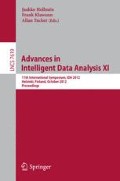Abstract
Over-fitting is a ubiquitous problem in machine learning, and a variety of techniques to avoid over-fitting the training sample have proven highly effective, including early stopping, regularization, and ensemble methods. However, while over-fitting in training is widely appreciated and its avoidance now a standard element of best practice, over-fitting can also occur in model selection. This form of over-fitting can significantly degrade generalization performance, but has thus far received little attention. For example the kernel and regularization parameters of a support vector machine are often tuned by optimizing a cross-validation based model selection criterion. However the cross-validation estimate of generalization performance will inevitably have a finite variance, such that its minimizer depends on the particular sample on which it is evaluated, and this will generally differ from the minimizer of the true generalization error. Therefore if the cross-validation error is aggressively minimized, generalization performance may be substantially degraded. In general, the smaller the amount of data available, the higher the variance of the model selection criterion, and hence the more likely over-fitting in model selection will be a significant problem. Similarly, the more hyper-parameters to be tuned in model selection, the more easily the variance of the model selection criterion can be exploited, which again increases the likelihood of over-fitting in model selection.
Over-fitting in model selection is empirically demonstrated to pose a substantial pitfall in the application of kernel learning methods and Gaussian process classifiers. Furthermore, evaluation of machine learning methods can easily be significantly biased unless the evaluation protocol properly accounts for this type of over-fitting. Fortunately the common solutions to avoiding over-fitting in training also appear to be effective in avoiding over-fitting in model selection. Three examples are presented based on regularization of the model selection criterion, early stopping in model selection and minimizing the number of hyper-parameters to be tuned during model selection.
Access this chapter
Tax calculation will be finalised at checkout
Purchases are for personal use only
Author information
Authors and Affiliations
Editor information
Editors and Affiliations
Rights and permissions
Copyright information
© 2012 Springer-Verlag Berlin Heidelberg
About this paper
Cite this paper
Cawley, G.C. (2012). Over-Fitting in Model Selection and Its Avoidance. In: Hollmén, J., Klawonn, F., Tucker, A. (eds) Advances in Intelligent Data Analysis XI. IDA 2012. Lecture Notes in Computer Science, vol 7619. Springer, Berlin, Heidelberg. https://doi.org/10.1007/978-3-642-34156-4_1
Download citation
DOI: https://doi.org/10.1007/978-3-642-34156-4_1
Publisher Name: Springer, Berlin, Heidelberg
Print ISBN: 978-3-642-34155-7
Online ISBN: 978-3-642-34156-4
eBook Packages: Computer ScienceComputer Science (R0)

